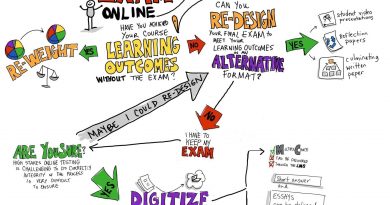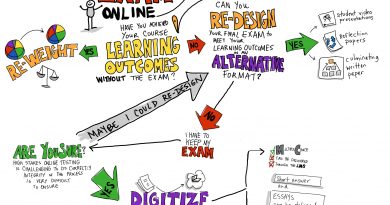
Working with Teaching and Learning Assistants Remotely
by Dr Lauren Crowe, Lecturer in Cell Biology and Dr. Annie Soisson Director of the Center for the Enhancement of Learning & Teaching
In remote teaching, you may need to rethink the Teaching Assistant (TA) or Learning Assistant (LA) role. Even in the absence of recitations or discussion groups in asynchronous online courses, TAs or LAs can still be involved promoting student engagement, developing content, and facilitating smooth virtual experiences. There are a range of ways to work together to offer the best support for learning and engagement and to minimize distractions so that you can focus on your role as the instructor. You may want to consider co-creating a memorandum of agreement and a new description of their role with their input and ideas, taking into account what resources and time constraints they may have to work with. This agreement can include how often and through what means you meet, how quickly they should respond to discussion boards, how they might run recitations, and other specifics regarding division of responsibilities. As with in-person teaching, you may want to include a statement like the one below to guide them in their interactions with students.
“When a student seeks individual help, first ascertain whether they have genuinely attempted the problem(s) or are merely trying to exploit you for 'easy answers.' After the student has shown you what they have tried, evaluate the specific skills that have already been mastered and point these out to the student. Pose leading questions which can lead the student through the remaining steps. Merely showing students how to do a problem helps little. It is the skills of problem solving that you are there to help them learn…Be as equitable as possible in distributing your time among individual students.”(Department of Computer Science, University of Maryland)
Below are some responsibilities that TAs or LAs can help with in both synchronous and asynchronous remote classes:
Synchronous Roles
Introduce students to the technology: TAs/LAs can conduct short intro sessions to familiarize students with new online platforms and video chat software.
Monitor Student Questions: TAs/LAs can monitor chats or other question forums and watch hand raising to help reduce class interruptions for minor/technical questions and to bring common question themes to the attention of the instructor. they can also collect questions not answered during the class sessions (e.g., from chat transcripts, recordings or whiteboards) to respond to later through email, Canvas announcements, discussion boards or in recitation.
Provide logistical supports during the class: If appropriate, TAs/LAs can record the session, save the chat transcript and white boards. They can also help assign students to groups, provide the professor with feedback on how things are (or are not) appearing online and share resources while the professor is leading the class. They can also help monitor small group discussions using the Zoom Breakout Room functionality. More on Managing Video Breakout Rooms
Asynchronous Roles
Support Student Engagement with Technology Used in the Course: First and foremost, TAs/LAs need to learn the software and which individual components of the software they should be able to handle, e.g., speed grader in Canvas, group discussions, assignments, etc. Instructors should point them to resources where they can learn how to use these tools and should be prepared to support students in using them.
Facilitate Community and Engagement: Ask if TAs/LAs have innovative or creative ideas on how to use online platforms for connecting with students, especially if they have taken online courses before. They can run virtual recitation sessions either in a chat or video format using technologies such as Zoom and GoogleHangout for video or Slack and GoogleChat for non-video chat. They can facilitate virtual small group discussions outside of class. For example, using Zoom breakout rooms for larger groups or having groups could sign up for slots to meet and discuss a topic for a small time block. TAs/LAs can maintain communication with the students through more informal means including via chat services like Google Chat, Slack. As near peers, they can be a preferred contact for students to talk to regarding stress and life issues. Within everyone’s comfort level, continue to rely on them for connecting with students on a personal level as well.
Develop and Curate Materials: TAs/LAs can support the course by uploading and organizing materials inside a Canvas course, captioning videos and editing or creating transcripts of lectures (Zoom can create audio transcripts of recordings) and reviewing materials for accessibility. Student Accessibility Services collects Resources for Faculty & Staff. TAs/LAs can also review assignment materials and online quizzes/homework assignments to catch mistakes or provide any other feedback on clarity before they are published for the students.
Create and Support Assessments: TAs/LAs can help to create online quizzes, polls, surveys (Poll Everywhere, Qualtrics, GoogleForms, Zoom polls, etc) or videos that demonstrate concepts usually presented in labs. They can answer student questions through online discussion forums on Canvas or other question platforms such as Piazza. It’s helpful for TAs/LAs to maintain an online presence in discussion forms. Not necessarily to answer student questions (let the students help each other out!), but to compliment insights or to ask students more probing questions in response to their discussion. TAs/LAs often play a role in grading or scoring virtually submitted homework. Please keep in mind that the best use of a TA or LA in this circumstance may be scoring true/false, multiple choice, etc. When asking them to evaluate complex answers or written responses you need to provide explicit training and support. When they’re doing a lot of the scoring, it may be helpful to involve them in creating a scoring rubric
Reference: Adapted from a post by Emily Mehlman, Rochester Institute of Technology
See Also
Image credit: Flowers frame a view of Tisch Library across the President’s Lawn (Alonso Nichols/Tufts University)



